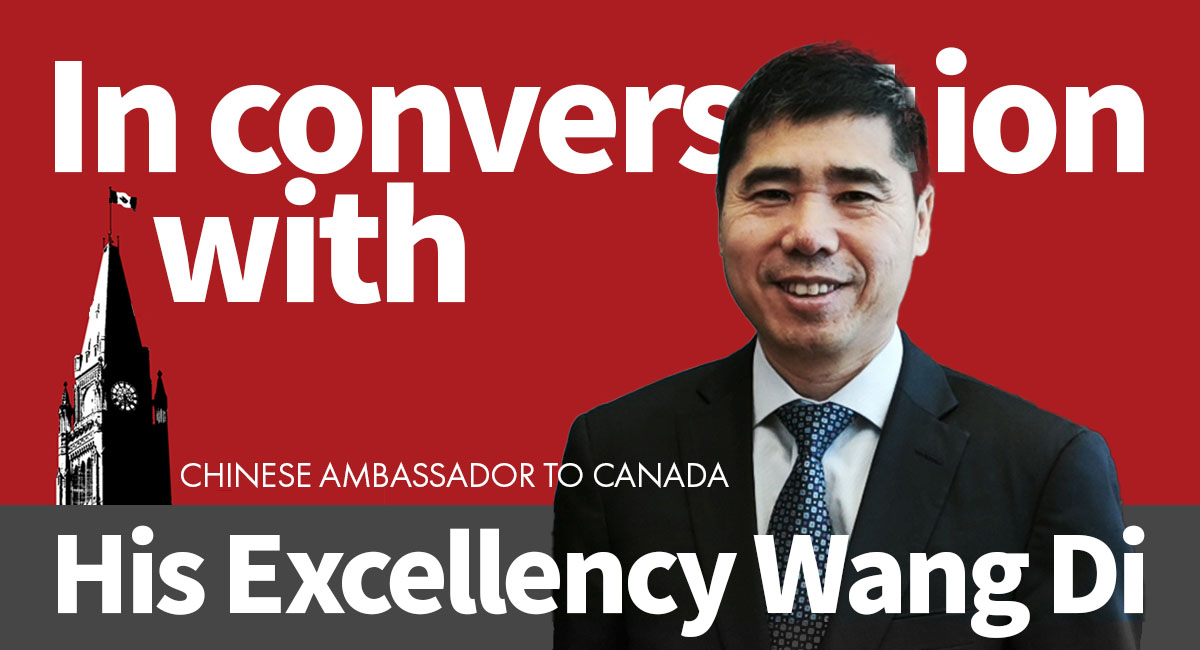
Educational Exchanges as a Catalyst for Stronger China-Canada Relations
Photo courtesy of Shutterstock.
The 45 years since the establishment of diplomatic ties between China and Canada in 1970 have witnessed steady progress and growth of the bilateral relations and cooperation in all areas. China-Canada educational exchanges and cooperation, like those in other fields, have also grown in depth and width, from exchange of scholars and students, training of teachers in the early years following the diplomatic engagement, to curriculum development, joint research, joint PhD programmes, and co-hosting of international conferences. The two-way interflow has served to enhance mutual understanding between the education authorities and academia of the two countries and improve the academic standards, and level of scientific research and education administration of both sides.
In 1973, a Memorandum of Understanding (MOU) between the Ministry of Education of China and the Department of Foreign Affairs, Trade and Development of Canada on the China-Canada Scholars’ Exchange Programme (CCSEP) was signed in Beijing. It was the result of an undertaking by then Chinese Premier Zhou Enlai and Canadian Prime Minister Pierre Elliott Trudeau. In the same year, the first group of nine Chinese scholars and students under the CCSEP left home for Canada in pursuit of more knowledge in the host country, thus starting the interflow of scholars and students between the two countries.
The CCSEP is the most important government-sponsored scholars and students’ exchange programme between China and Canada. Since its launch the programme has sponsored over 1,000 Chinese and Canadian students and scholars for their pursuit of research in humanities and social sciences in the host country. Among them, to name just a few, are former Chinese ambassadors to Canada Lu Shumin and Lan Lijun, former Chinese UNESCO ambassador Zhang Xuezhong, Canadian Assistant Deputy Minister of Foreign Affairs Susan Gregson, former minister of the Canadian Embassy in China Sarah Taylor, and Vice-President of Colleges and Institutes Canada (CICan) Paul Brennan. The CCSEP is the longest-standing, most influential and highest-level exchange programme between China and Canada for personnel exchange and training.
In 1983, the Chinese and Canadian governments signed a China Aid Programme funded by the Canadian International Development Agency (CIDA). The educational cooperation projects under CIDA China Aid Programme have played a positive role in China’s higher education reform and development. These projects include the China-Canada Management Education Programme 1983-1996 (CCMEP), the China-Canada University Linkage Programme 19881995 (CCULP), the Special University Linkage Consolidation Programme1996- 2001 (SULCP), and Strengthening Capacity in Basic Education in Western China 2002-2007.
Specially designed to cater to the needs of China’s higher education development with focus on capacity-building, the CIDA programmes and projects have achieved remarkable results in respect of curriculum development, personnel training and joint scientific research.
Over half of Canadian universities were committed and involved in the CIDA education-related programmes to develop cooperation with Chinese universities. These programmes have facilitated exchanges and cooperation between Chinese and Canadian higher-education institutions. They have also contributed to the internationalisation of Chinese higher education institutions. China’s first Master of Business Administration (MBA) programme, its first Master of Public Administration (MPA) programme and the development and improvement of disciplines in medicine, environment, agriculture, nursing and others are, in fact, practical outcome of the China-Canada higher education cooperation.
In 2005, the Chinese Ministry of Education and Agriculture and Agri-Food Canada signed a MOU on Scientific and Technical Cooperation and Personnel Training in Agriculture. Over the past decade, over 400 Chinese PhD candidates and researchers from 40 Chinese higher education and research institutions came to Canada and pursued joint scientific research in a dozen of specific fields at 15 research centres or laboratories under Agriculture and Agri-Food Canada. More than 100 Canadian agricultural scientists provided supervision and guidance to the Chinese PhD candidates, and participated in the joint research. Over 260 Chinese PhD candidates under the joint doctoral programmes have completed their planned research and studies, and returned to China. The Chinese and Canadian researchers have published over 1,000 co-authored publications in international academic journals.
In 2006, the Chinese Ministry of Education signed separate personnel training cooperation agreements with the Canadian Institutes of Health Research (CIHR) and the
National Research Council of Canada (NRC). The agreements provided a framework for Chinese students of high academic merit to pursue PhD research at Canadian universities with sponsorships jointly provided by the China Scholarship Council and the Canadian institutions.
In July 2005, the first Confucius Institute in Canada was inaugurated at the British Columbia Institute of Technology (BCIT) in Vancouver. There are now 12 Confucius Institutes and 18 Confucius Classrooms in Canada. The Confucius Institutes operate on the principles of equality, mutual benefit and win-win cooperation. A Confucius Institute may be established in Canada upon the Confucius Institute Headquarters’ approval of a joint application submitted by a Canadian host institution and its Chinese partner institution.
Over the past ten years, the Confucius Institutes/Classrooms in Canada have been geared towards Canadian students and general public.Apart from providing courses on Chinese language and culture, they have organized a variety of activities for students to gain first-hand experience of Chinese culture.They have also held academic seminars and workshops on China-related topics. While contributing to multiculturalism in the host country, they have also played a positive role in promoting cultural and people-to-people exchanges between China and Canada and enhancing mutual understanding and friendship between the two peoples.
In 2010, the Chinese Ministry of Education and the Council of Ministers of Education Canada (CMEC) held their First High-Level Consultation on Education Collaboration, and reached broad consensus on all-round collaboration in education.Two more rounds of the High-Level Consultation have been held since.The High-Level Consultation has led to a variety of projects of educational cooperation between provinces and universities of the two countries, ranging from the exchange of university faculty and students, joint operation of education institutions, joint research to cohosting of academic seminars and workshops.
As of now, 640 cooperation agreements have been concluded between universities and education institutions of the two countries,with 75 education institutions and programmes jointly established and operated by Chinese and Canadian partners.
The University of Alberta has developed extensive exchanges and cooperation with Chinese universities and education institutions. The university now hosts nearly 5,000 Chinese students. As of now, its professors and their peers of Chinese universities co-authored a total of 3,615 papers. Since 2011, UAlberta, with funding of the China Scholarship Council, has provided professional development courses for 200 education administrators from 70 Chinese universities through its Global Academic Leadership Development Programme.
As of the end of 2013, the Chinese Ministry of Education had concluded agreements on mutual recognition of academic degrees and credentials with the education authorities of 10 Canadian provinces, and signed MOUs on educational exchange and cooperation with Quebec,Alberta and British Columbia. All this formed a solid foundation for educational co-operation between China and Canada.
On 17 October 2015, the Shanghai-Ottawa Joint School of Medicine welcomed its first batch of 56 students with a white coat ceremony, where teachers and veteran medical professionals formally dressed medical students in white coats, the garb traditionally considered a symbol of purity, compassion and devotion, and where medical students publicly affirmed their commitment to medical professionalism and mandate to preserve life and serve patients with dedication.
The Shanghai-Ottawa Joint School of Medicine is jointly established by the Shanghai Jiao Tong University School of Medicine and the University of Ottawa Faculty of Medicine. As of now, it is the first and only Chinese-foreign joint undergraduate clinical medical education institution approved by China’s Ministry of Education.
According to the latest statistics of the Canadian Bureau for International Education (CBIE),China is the number one country of origin for international students in Canada. In 2014, students from China made up 32.96 per cent of the international student population in Canada, totalling 110,918 while the number of Canadian students in China stood at 3,271.
In 2015, with a view to encouraging more students to study in China, the University of Alberta proposed a Canada Learning in China Initiative, a credit-gaining programme, to be jointly sponsored by participating Canadian universities, Chinese Ministry of Education and Chinese higher education institutions. In 2016, the first cohort of 200 Canadian undergraduate students are expected to start their study in China.
The extensive and wide-ranging educational exchanges between China and Canada are of far-reaching significance. The exchanges of students and scholars and cooperation in scientific research have served to strengthen mutual understanding and friendship between the two peoples, and acted as catalyst for further development of China-Canada relations.









